For anyone who's interested, I thought I'd share the DSP settings I've created for the EAW VR series speakers that I use. These cabinets were the best I could afford a few years back and when I got access to Lake processing (for reasons I won't go into here), I figured I'd bi-amp the VR21's to squeeze a little more power and quality out of them. (I know, for many people, these cabinets are on the cheap end of the scale. Please, no flaming.  ~
~ ~:smile
~:smile
I'd welcome any comments or feedback on this. I've kind of made this up as I go.
Here are screen shots of the module.
Delay's
- 0.44ms to align the VR21 12" with the horn
- additional 5ms on the VRS12 to match the delay of the linear phase crossover used in the VR21

Gains

VRS12 2 x 12" sub.
- EAW recommended HPF and parametric.
- Linkwitz-Riley LPF to cross with the VR21

Linear phase brick wall crossover for the VR21
- LPBW chosen to reduce lobing around the crossover region
- 5ms delay
- 1.2kHz somewhat arbitrary

EQ for the VR21
- Created using pink noise and SysTune at about 1m.
- Note the notch at 3.6 kHz. (I could hear some weird resonance.)
- The highs are adjusted to taste in each venue using another overlay

Best,
Michael
I'd welcome any comments or feedback on this. I've kind of made this up as I go.
Here are screen shots of the module.
Delay's
- 0.44ms to align the VR21 12" with the horn
- additional 5ms on the VRS12 to match the delay of the linear phase crossover used in the VR21

Gains

VRS12 2 x 12" sub.
- EAW recommended HPF and parametric.
- Linkwitz-Riley LPF to cross with the VR21

Linear phase brick wall crossover for the VR21
- LPBW chosen to reduce lobing around the crossover region
- 5ms delay
- 1.2kHz somewhat arbitrary

EQ for the VR21
- Created using pink noise and SysTune at about 1m.
- Note the notch at 3.6 kHz. (I could hear some weird resonance.)
- The highs are adjusted to taste in each venue using another overlay

Best,
Michael


